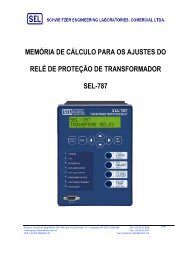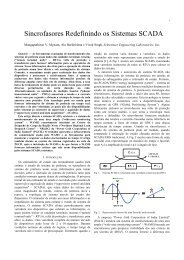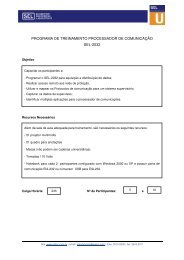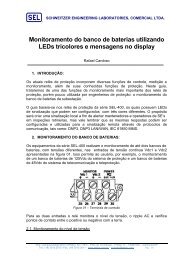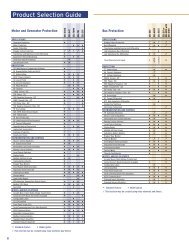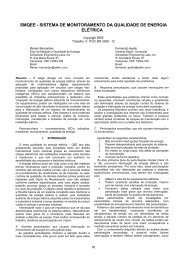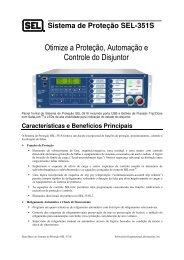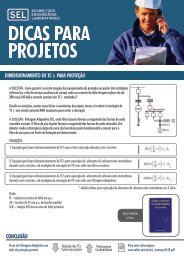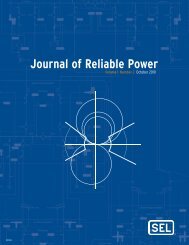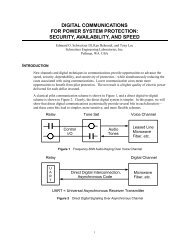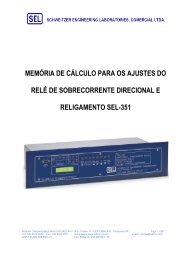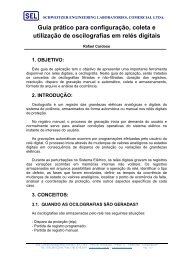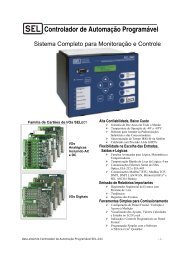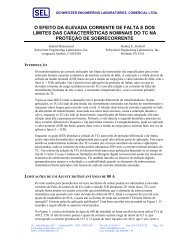Journal of Reliable Power - SEL
Journal of Reliable Power - SEL
Journal of Reliable Power - SEL
You also want an ePaper? Increase the reach of your titles
YUMPU automatically turns print PDFs into web optimized ePapers that Google loves.
80<br />
60<br />
40<br />
20<br />
R F<br />
100<br />
3 3<br />
S<br />
2<br />
5 6<br />
4<br />
1.5 1.5<br />
4 4<br />
1 3<br />
1<br />
2<br />
1<br />
2<br />
Figure 9 Fault Resistance Regions Covered by the Schemes in Figure 8<br />
The standard IEC 834-1 suggests that the user should<br />
decide the states <strong>of</strong> communicated bits, given a loss <strong>of</strong><br />
communications. For example, during a loss <strong>of</strong><br />
communications, should the received bit maintain (hold) its<br />
previous state, or default to a 1, or to a 0 As we apply bits in<br />
various schemes below, we will also determine the desired<br />
action <strong>of</strong> the bits given communication loss.<br />
A local Zone 1 element, such as a ground quadrilateral<br />
element, trips the breaker directly. Non-pilot tripping<br />
covers the area <strong>of</strong> overlap <strong>of</strong> the zones 1, marked by the<br />
circled 1 in the house-shaped characteristic in Figure 9.<br />
We must rely on the channel, or wait for zone timers<br />
for all other faults. Appendix A gives some guidelines<br />
for setting the resistance and reactance reaches, taking<br />
into consideration some <strong>of</strong> the angle errors that might<br />
be expected.<br />
The remote Zone 1 element state is communicated on<br />
one bit and passes through a local security counter to<br />
provide a Direct Transfer Trip. The additional regions<br />
covered are marked by the circled 2s. Given a channel<br />
failure, the received bit should default to a ‘0’. (A<br />
default <strong>of</strong> ‘1’ would trip the remote breaker for<br />
communications failures; a default <strong>of</strong> ‘hold’ defeats the<br />
receive security counter.)<br />
PUTT and short-POTT schemes follow:<br />
In a PUTT scheme (not shown in Figure 8), the local<br />
Zone 2 element would be set to reach beyond the<br />
remote end. The remote Zone 1 element is an<br />
underreaching element. The scheme is fast and<br />
simple—and is not encumbered by current-reversal<br />
timers or logic, which might delay tripping for faults<br />
that evolve to the healthy line.<br />
A short-POTT scheme can also be considered here, and<br />
is illustrated in the figures. The Zone 1.5 elements at<br />
2<br />
R F<br />
R<br />
each terminal would be set to cover the entire line, but<br />
would have their reaches limited sufficiently to avoid<br />
current-reversals on parallel paths. This improves faultresistance<br />
coverage and speed over PUTT, but does not<br />
involve current-reversal timing.<br />
Elements for a short-POTT scheme are labeled 1.5, and<br />
cover the additional area marked with the circled 3.<br />
The received bits should default to ‘0’ for<br />
communications failures. There is no benefit to<br />
holding—only risk.<br />
A POTT scheme based on directional overcurrent<br />
elements, labeled Zone 2, can provide some more<br />
sensitivity, but must be guarded against current<br />
reversals. Reverse-looking elements (Zone 3 directional<br />
overcurrent elements) and timers provide blocking for a<br />
short time after current reverses. The delay that would<br />
result if a fault evolved from one line to the other is not<br />
important, because <strong>of</strong> the coverage by the PUTT or<br />
short-POTT schemes. A timer could be added after the<br />
AND-gate, to gain some security against system<br />
unbalances produced by switching, for example. The<br />
additional coverage from the POTT scheme is labeled<br />
with the circled 4.<br />
Received bits for Zone 2 should default to ‘0’ on loss <strong>of</strong><br />
channel. A ‘hold’ or ‘1’ would significantly risk<br />
misoperation, with little or no benefit in dependability.<br />
The Zone 3 received bits should default to a ‘0,’ if<br />
communications are lost. A default to a ‘1’ would<br />
defeat the protection for T seconds for every bit error.<br />
A high-resistance fault close to S could be in region 5,<br />
which is not covered by the POTT scheme. After some<br />
time delay, and if no reverse elements pick up at the<br />
remote end, we can trip for such a fault, with the<br />
sensitivity we are accustomed to with DCB schemes.<br />
However, this scheme enjoys much greater security<br />
than DCB.<br />
Conventional blocking schemes assume the fault is<br />
internal if the blocking message is not received. (The<br />
truth might be that the channel or relay equipment<br />
failed to deliver the message to block. Put another way,<br />
in traditional DCB schemes, the block signal means<br />
“reverse.” No block signal means “forward,” “not<br />
detected,” or “bad channel.”)<br />
Here, the local terminal knows with near certainty the<br />
states <strong>of</strong> the remote forward and reverse elements, or it<br />
knows the channel is down. There is no confusing a lost<br />
channel with an internal fault. The fact that we are<br />
receiving messages from the remote end reassures us<br />
that the remote relay is functioning, and ready to<br />
produce blocking signals when appropriate.<br />
In addition, the security can be enhanced somewhat by<br />
an undercurrent element, 50N. This element would<br />
block tripping, if enough residual current is produced<br />
by an open CT, for instance.<br />
Digital Communications for <strong>Power</strong> System Protection: Security, Availability, and Speed | 37



